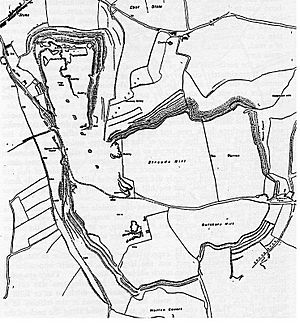Ham Hill Hillfort facts for kids
Quick facts for kids Ham Hill Hillfort |
|
|---|---|

Looking east from the highest point of Hamdon Hill (on top of the inner rampart of the hillfort) towards the Stoke-sub-Hamdon war memorial which was unveiled in 1923
|
|
| Location | Ham Hill, Somerset, England |
| Area | 210 acres (85 ha) |
| Built | Iron Age |
| Reference no. | 1043362 |
| Lua error in Module:Location_map at line 420: attempt to index field 'wikibase' (a nil value). | |
Ham Hill Hillfort is a really old fort built on a hill in Somerset, England. It was built during the Iron Age, but people lived here even before that, during the mesolithic and neolithic periods. Later, it was also used during Roman and medieval times.
This fort is a Scheduled Ancient Monument, which means it's a very important historical site that is protected. The whole hill is also a special geological area and a country park. Lots of people visit Ham Hill every year – over 250,000!
This hillfort is huge! It covers about 210 acres (85 ha), making it one of the biggest hillforts in Britain. Guess what? It's the only one that has a public house (a pub) inside its ancient walls!
Contents
What is a Hillfort?
Hillforts like Ham Hill were built a very long time ago, around 3,000 years ago. They were usually built on top of hills, which made them easy to defend. People aren't totally sure why they were built. Some think they were military sites to protect against invaders. Others believe they were built because more people were living in Britain, and there wasn't enough land or food for everyone. This could have caused arguments, and the hillforts offered a safe place for communities to go.
Archaeologists believe that hillforts were not just for fighting. They were also important places for communities to gather, trade, and live. If there was trouble, they could become strongholds.
Exploring Ham Hill
Ham Hill rises to about 400 feet (120 m) above sea level. It stands tall over the Parrett and Yeo river valleys nearby.
The hillfort has huge walls, called ramparts, that are about 3 miles (5 km) long. These walls surround an area of 210 acres (85 ha). The fort is shaped a bit like an "L".
Most of the fort has a double bank and ditch around it. Some of these banks are as high as 12 metres (39 ft)! There are two main entrances. One is in the south-east, where a modern road now runs. The other is in the north-east, following a path from the Church of St Mary the Virgin in Stoke-sub-Hamdon.
A Long History
People have lived on Ham Hill for a very long time. It was used during the mesolithic and neolithic periods, which were thousands of years ago. Later, the Durotriges tribe lived here, starting around the 1st century BC.
Archaeologists have found many interesting things at the site. These finds show that people were living here as early as the 7th century BC. They have found bronze items, parts of chariots, iron bars used as money, and gold and silver coins. They also found sling stones and a special type of pottery.
In 2013, archaeologists found some human skeletons. These might be from the 1st or 2nd century AD. Marks on the bones suggest that some bodies were prepared in special ways, and some might show signs of fighting.
Roman Times
Ham Hill was also very important during the Roman era. Many discoveries suggest there was a building here, maybe even a Roman villa. It might have been a Roman fort, helping to control the famous Fosse Way road.
Roman coins have been found, dating from the time of emperors like Domitian to Constantine the Great. One pot found in the 1800s contained 338 Roman coins! Other pots held over 1,000 coins from different Roman periods. Pieces of scale armour, called lorica squamata, have also been found.
Later History
There isn't as much evidence from the Saxon era, but the site might have been used then too. It was definitely used during medieval times. There was even a small village here called South Ameldon. This village held a yearly fair and court from 1102 until the 1600s. In the 1300s, part of the site was used to raise rabbits.
Quarrying and the Stone Circle
Over the years, parts of Ham Hill have been changed by quarrying for Hamstone. This is a special type of stone found on the hill. In the 1800s, there were 24 small quarries here, with about 200 men working. Today, there are two quarries, both owned by the Duchy of Cornwall. The pub on the hill is even named after them!
In 2000, a stone circle was added to the hill. It's made of 15 Hamstones and remembers all the people who have worked quarrying stone on the hill since Roman times.
Images for kids



